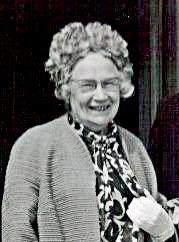
Welcome to our History - Past & Present page which we have added because of a growing interest generated by the website in the historical development of the village of Westmuir. We already have a number of interesting articles included below. If you have similar information which you think would be of interest to others please get in touch and let us know. We'd be delighted to hear your feedback.The links below will take you directly to the article of your choice or you can read them all by scrolling down in the normal way.
Westmuir’s Special Day in March 2019
The closeness of two specially memorable dates which directly affected the residents of Westmuir Village and its environs became the focal point for a day of events on Saturday 16th March 2019. The central figures on those occasions were ancestors of the Munro family from nearby Lindertis.
Equally important and in more recent times, has been the immense support from the great grandson of Sir Hugh Munro. It was Lord Colyton of Lindertis who made it possible for the village to develop its Community Woodland which was opened officially in 2007. The provision of this wetland offered the ideal conditions required for wildlife habitat and for the layout of footpaths. The Community Woodland has proved to be of great value to village friends of all ages and abilities. On 25th August 2007 the Woodland was officially opened and Lord Colyton’s younger son Tom Hopkinson, Great, Great Grandson of Sir Hugh, planted a tree to mark the occasion.
Westmuir’s ‘Celebration of Munro’ - Saturday 16th 2019
The community turned out in force for a Celebration Coffee Morning and two Mountain Climbing presentations given in the evening. In the morning, stories were shared and good humour was the predominant feature of a memorable occasion. There were various displays for people to enjoy from Lindertis early 1900s to present times. There was even a ‘Future’ display highlighting the fact that a crowdfunding appeal had begun that very day towards the provision of a defibrillator for the village Phone Kiosk. The most evocative photograph was the one (probably by Valentines of Dundee) taken about 1920, and certainly before the arrival of the Hall or the Phone Kiosk.
It was Sir Torquil Munro who was the driving force behind the building of Westmuir Hall. His determination to see this through was always remembered and his continued support as Trustee of the Hall for over 50 years is still logged in the Hall Trustees Book. His sister Carmen was also a Trustee for over 50 years and she was the representative for the village WRI. The Celebration Coffee Morning was well attended and the display notices and photographs prompted lots of good ‘memories’.
The occasion was further enhanced by the continuous slideshow of the West Highland Way compiled by Richard, a member of the Westmuir Walkers Group. Richard has completed the route four times and the walk featured on the slideshow was perhaps his most memorable. Along the way Richard and team met a group of walkers from Denmark who were enjoying every minute of their hill-walking in Scotland. The Danes carried their tents, all walking gear, a couple of musical instruments and their song sheets (mainly Beatles songs). Richard had taken his guitar along and with his family team members had opted for Bed and Breakfast. The evening ‘rest times’ along their West Highland Way route were indeed memorable, when the Danes and Scots met up for a beer and a song. Richard was completing his walk in aid of an important charity and when he bid the Danes farewell, they presented him with a Whisky bottle container filled with money for his charity. This certainly proves that the camaraderie of walking in the Hills does exist.
The highlight of the coffee morning was when Lord and Lady Colyton arrived with son James, daughter Katie and grand-daughter Esme. Lord Colyton’s full name is Alisdair James Munro Hopkinson and he is a great grandson of Sir Hugh Munro. It was also very exciting to learn from Pippa, Lady Colyton that the name Munro continues. Their eldest son is James Patrick Munro Hopkinson and James’ son is Hugh Nicholas Munro Hopkinson. Lady Colyton suggested that “Perhaps little Hugh will become a famous man of the Scottish Hills like his great, great, great Grandfather although the early indications are that his twin sister Suzannah has inherited all the intrepid Munro genes as she’s showing distinct signs of adventurousness" – just like Great Granny Fiona!
Many of the attendees during the morning had connections with Lindertis. Some had spent their childhood years there or their Parents or Grand-Parents had worked at Lindertis. Village friends like Robbie and Reta Adam had worked hard for many years supporting the village hall and to have a chance for fun and banter with Alisdair, Lord Colyton was just ‘ the icing on the cake’.
The evening event was planned entirely to recognise the work of Sir Hugh Munro who is known far and wide for his contribution towards locating and measuring our Mountain ranges in Scotland and particularly those over 3,000ft in height. He published his first list of ' Munros' in 1891. Two presentations on climbing and hill-walking were given with mountain peaks over 3,000ft highlighted and of course many climbers over the years have sought to ‘bag’ all 282 of them. Jeremy Morris spoke first about his own journey through the Munros and Isdale Anderson then described his long distance high level trek of the GR20 in Corsica, which runs the length of the Mediterranean Island.
The evening programme was linked with some aspects of the wider interests and character of Sir Hugh. He went to Stuttgart aged 17 to learn German and from there he developed a love of serious climbing in the Alps. Later he took an active part in the Basuto Campaign of 1880 and was awarded a medal and clasp. Sometime later he was appointed as a King’s Messenger of Foreign dispatches which might have required travelling to unsafe destinations.
Sir Hugh’s wife Selina died in 1902 and his young family were clearly very close to him. In the spring of 1918 Sir Hugh went over to Tarascon in Provence with his two daughters Carmen and Morna. Working with the French Red Cross and aided by his daughters, he set up his own Canteen to aid soldiers. In January 1919 all three returned to Tarascon to work in the Canteen and to help the troops returning from the war. Sadly, Sir Hugh became seriously ill and died on 19th March 1919. His funeral procession at Lindertis on 2nd April was followed by pupils and teachers from Westmuir School, Airlie School and Kingoldrum School also the Tennantry and staff from Lindertis and many friends and family.
The evening event was made all the more enjoyable when members of the Munro family came along again - Lady Colyton, son Tom and his wife Gemma. Great fun ensued with the drawing of the raffle tickets but soon it was time to call it a day. The Celebration Day came to a close after Tom with wife Gemma alongside, cut the celebration cake or ‘Cake of Tarascon’ as it became known! This was accompanied by a Glass of Bellini or Kir Royale for all present.
Sincere Thanks to one and all:
To the Lindertis Munro family for making the entire event so extra
special.
To All of the Helpers – setting up the Hall, Baking, providing Raffle
prizes, helping with the coffees / teas / serving cakes/ selling cakes, books, plants,
raffle tickets / Screen and equipment for the speakers etc. etc.
To Jeremy Morris, Isdale Anderson, Richard Forsyth – for all
their climbing stories and slideshows / photos.
To Everyone who came along on the day and supported the events.
To Ian Christie, our Alpine Specialist, who brought some beautiful
plants to present to Lord and Lady Colyton and family. The descriptions of each plant
were magical in themselves e.g. “Dryas octopetala, The Mountain Avens, can be found
growing in large patches above Glen Doll”
To Rebecca Elder who made our Tarascon Cake exactly as had
been requested. A lemon flavoured cake and easy to serve no matter how many people came to
the Hall. Rebecca (22 years of age) whose Grannie stays in Westmuir, is embarking on a cake
making business. We wish her lots and lots of good fortune. Rebecca’s telephone
number is 07933132982
To Tarascon, Provence for sending flowers for Sir Hugh on 2nd April 1919
with accompanying messages from the Société des Amis de France, Souvenir de
Hotel des Empereurs and Société de Secours aux Blesses; Comitie de .
And finally to Helen Humphreys, whose idea it was to plan this wonderful event in Westmuir and who skilfully brought together all the people, guests, volunteers, history, displays, speakers and everything that made the day such a success to mark a special day in the history of the village of Westmuir.
-oOo-
Lindertis House & The Munro Family
In 1808 Gilbert Laing Meason purchased the lands of Lindertis, which lies about four miles west of Kirriemuir on the north side of the road leading to Blairgowrie. He was the 2nd son of Robert Laing the Laird of Strynzie in Orkney and succeed his Cousin Gilbert Meason of Moredon, by whose deed of settlement in 1808, took the name and arms of Meason. Through his marriage in 1811 to Mary, daughter of William Weymss of Cuttlehill, their combined fortune was considerable, and it was lavishly spent on their newly acquired property. Between 1814 and 1817 they had the square Castellated House built which formed the main building, the design having been drawn up by Elliot of Edinburgh in 1813.
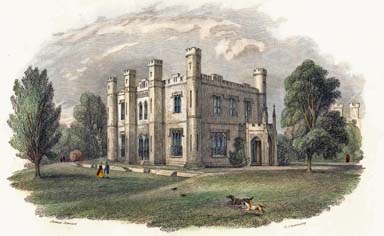
The policies and gardens had also been laid out by Mr Laing Meason. In fact everything was done on a grand scale, with the result that when he died in 1832, his son Magnus Laing-Meason fell into financial difficulties and Lindertis was sold in 1838, on behalf of the creditors, to the Trustees of Major-General Sir Thomas Munro, Baronet, who had died in India in 1827. By his settlement a certain portion of the considerable fortune which he left to his elder son and heir to the Baronetcy was to be invested in land. Lindertis was purchased and managed until their ward came of age.
Thomas Munro, Second Baronet was born in India in 1819; he made additions to the estate with the purchase of Auchendorie and Baldovie in the 1860s. In 1864 he made considerable additions to the Lindertis House, one of these being the west wing. Sir Thomas was never married so on his death in 1901, his younger brother Campbell Munro became Third Baronet. Sir Campbell was born in India in 1823 and he chose the army as a career rising to the rank of Captain in the Grenadier Guards. Through his marriage in 1853 to Henrietta Maria Drummond they had nine of a family, of whom the eldest was Hugh Thomas.
Hugh Thomas Munro, Fourth Baronet, was born in 1856. In 1899 the lands of Lindertis and Baldovie were conveyed to him by his uncle, Sir Thomas Munro, and on his father's death in 1913 he took the title 4th Baronet. Sir Hugh Munro is best remembered for his table of Scottish mountains of 3000 feet and over which was published in 1891 in the Scottish Mountaineering Club Journal. This caused a great stir among active mountaineers, who saw the challenge of climbing all the mountains on the list as a lifetime ambition. Of his total of 538 main summits and tops, it is reckoned he had only 3 summits still to climb when he died in France in 1919. His son Torquil, becoming the 5th Baronet.
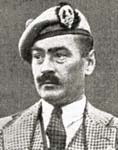
Thomas Torquil Alfonso Munro, Fifth Baronet, was born in Edinburgh in 1901 and educated at Winchester. He was best known as a farmer, particularly as an Aberdeen Angus breeder and Judge. He got his name in the record books when his Aberdeen Angus bull 'Lindertis Evulse' was sold at the Perth Bull Sales, in 1963, for the world record price of 60,000 guineas. Many of his other championship bulls were exported to other countries. Sir Torquil was well known in his younger days as a host for society parties which were attended by pre-war British film stars and for many years he was one of the organisers of the Angus County Ball, which he attended in red kilt, jacket and red stockings. In 1928 Torquil made it possible for the people of Westmuir to erect their village hall with the gift of a piece of land.
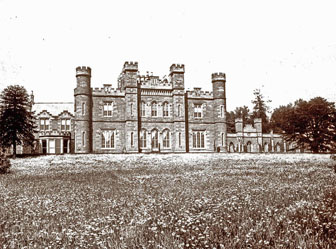
By 1947 with the family living in the nearby Drumleys House and the large mansion house becoming more of a burden than an asset, the main building was stripped of all valuable building materials. Special care was taken with the library, with its roll-shuttered walnut bookcases and doors that resembled shelves of books.
The main building stood for a long time after this as a roofless shell. The west wing was converted into flats which were last occupied in 1965/6. For health and safety reasons, children playing in the buildings, lighting fires etc., all of buildings were finally demolished in 1987.
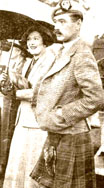
Sir Torquil's grandson, Alisdair John Munro Hopkinson (through Sir Torquil's second marraige - to Averil Moira Catherine Hunter) is the present landowner and manager of the Lindertis/Munro estates.
With thanks for this article to David Fawcett
Stuart McGugan, Actor who lived in Westmuir during the early years of his life.
Stuart was first seen on television as a presenter on BBC's Play School in 1964 (he regularly presented the programme for more than 20 years), but he is probably best known for playing Gunner 'Atlas' Mackintosh in the BBC sitcom It Ain't Half Hot Mum. Originally from Stirling, he has kindly sent us this account of his family's sojourn in "Carraig."
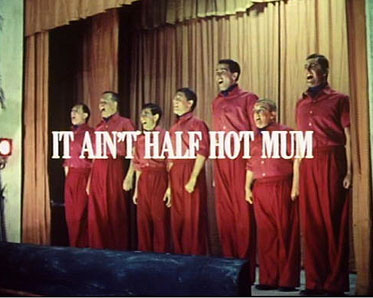
Stuart McGugan
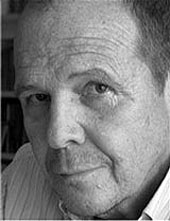
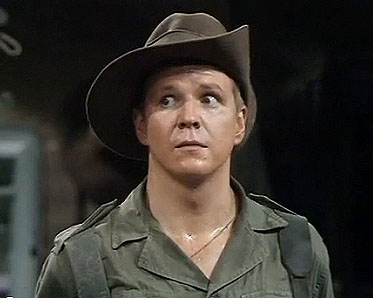
"We arrived around 1957, moving from Letham, Angus. I was a pupil at Forfar
Academy. I left Forfar Academy, after five years' senior secondary education,
with an Intermediate Swimming Certificate, which I passed by rescuing a drowning brick from
the bottom of Forfar Swimming Pool while dressed in my pyjamasl
I was therefore very grateful to Willie Ogilvy, chief printer at the Kirriemuir Herald, for
my first job as his reporter. I was with the Herald, or as it was more unkindly
known, the two minutes' silence, for eighteen months, during which time the McGugans moved
from "Carraig" to a house my Dad had had built at the Welton Corner, between
Forfar and Kingsmuir.
Among my most vivid memories of my time in Westmuir are riding my sister's pony through the
raspberry fields and up the hills over the road opposite the house: illegally driving my
Dad's car, while under age, along the great straight stretch of road towards Alyth; and the
great teenage parties we held in the what used to be the billiard room in
"Carraig."
As we were at the bottom of the hill out of Kirriemuir, any time there was a serious
snowfall the family played host to stranded lorry and car drivers. I remember my
parents were thanked by one guy from up Glen Isla with a whole side of
venison.
I first started acting around the time I lived in Westmuir, joining the Thrums Dramatic
Society and the Kirriemuir Amateur Operatic Society - both great places to meet
girls! One play, "Bed of Roses" by Falkland L Cary - weird the useless
pieces of information which stick in the mind - toured to Lintrathen. The local hall
was packed, kids in the front rows, courting couples in the middle, Mums and Dads keeping an
eye on it all at the back. There was a long tea-party scene and we were stuck at the
very edge of the tiny stage. We were so close to the front row that when I got up to
leave the tea-party, I discovered someone had tied my shoe-laces together....
After a clutch of newspaper jobs I went to the College of Dramatic Art in Glasgow for three
years, and I've been in the acting business ever since. This has ranged from
seasons with the Royal Shakespeare Company and the National Theatre and theatre tours to
television shows and series like "It Ain't HAlf Hot, Mum," "Playschool,"
"The Chief," "Tutti Frutti," "Hamish
MacBeth,""Benidorm" etc., etc.
There is one long-lasting response to my stay in Westmuir. Years later I took a
rush of blood to the head and bought a house in the Languedoc region of the south of France.
I didn't realise it at the time, but I've since noticed that the view from the house
in France is identical to the wonderful view I had from my top-floor bedroom in
"Carraig." If you substitute the sunflowers with potatoes and the
vines with rasps you've got the same sweeping view from Westmuir down the Strathmore valley,
with Forfar over to the left, and down towards Perth on the right. Only in France with
more predictable sunshine....."
Very best wishes,
Stuart.
Canon Harry Rorison
The gentleman pictured below is Canon Harry Rorison, a Westmuir character from the past, who lived at Downfield Cottage.
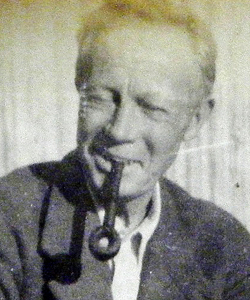
Click Here
or on the picture to read an article which has been researched and compiled by Helen
Humphreys with help from Hector MacLean (of Balnaboth) who kindly provided some of the
information and photographs.
Westmuir - A Historical Summary
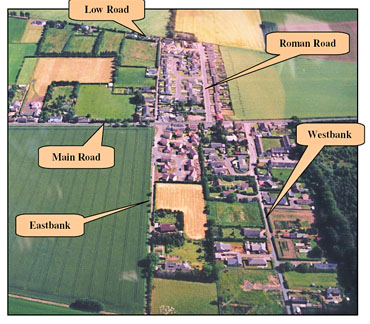 Northmuir, Southmuir and Westmuir were specifically created by the Kirriemuir authorities
in 1815 ostensibly to allow the town to develop. At Westmuir more than thirty
smallholdings were laid out to enable handloom weavers and their families to practise
self-sufficiency whilst plying their trade. However there is evidence to
suggest that all three hamlets were located on the edges of the town/parish boundaries in
order to deter local farmers who were encroaching on the town’s common
lands. This would explain why the Westmuir is a mile out of town and not at
Herdhill. About a third of the initial buildings survive in one form or another and many
of the smallholdings and their wells can be located. In addition at least two
communal wells were sunk outside the present shop and in
Roman Road. Some of the smallholdings were located along the
Airlie/Kirriemuir road which bisects the village. Most were sited
to the north and south of the main road and were reached by paths between the plots and
fields. These footpaths in time developed into the four side roads on which
most of the village housing is now to be found.
Northmuir, Southmuir and Westmuir were specifically created by the Kirriemuir authorities
in 1815 ostensibly to allow the town to develop. At Westmuir more than thirty
smallholdings were laid out to enable handloom weavers and their families to practise
self-sufficiency whilst plying their trade. However there is evidence to
suggest that all three hamlets were located on the edges of the town/parish boundaries in
order to deter local farmers who were encroaching on the town’s common
lands. This would explain why the Westmuir is a mile out of town and not at
Herdhill. About a third of the initial buildings survive in one form or another and many
of the smallholdings and their wells can be located. In addition at least two
communal wells were sunk outside the present shop and in
Roman Road. Some of the smallholdings were located along the
Airlie/Kirriemuir road which bisects the village. Most were sited
to the north and south of the main road and were reached by paths between the plots and
fields. These footpaths in time developed into the four side roads on which
most of the village housing is now to be found.
To the north of the main road lie East and West Bank, the latter was and sometimes still is known as Old School Road or School Brae, names which explain why it came into use in the 1870s to service the new village school. Prior to that date early O.S. maps indicate that the western houses of the village were accessed by ‘the Strippie’ now a wide but partially overgrown footpath between the Parish Boundary mound and the property boundaries. The title is not as one might presuppose a familiar diminutive common to locals – as with ‘Shoppie’, but is an actual Old Scots term for an approach road.
East Bank sometimes known as Rossiebank from the property at the northern end certainly predates the 1815 village and was the trackway which led to Cloisterbank whose buildings have disappeared in the last fifty years. This farm was reputed to be the site of the late 18thC confrontation between the townsfolk of Kirriemuir and the surrounding farmers when disagreements over the hoarding and price of grain led to the fisticuffs described in Reid’s ‘Regality of Kirriemuir’ as the Battle of Cloisterbank. In fact the name itself may well suggest even greater antiquity. In 1202 A.D. Gilchrist, Earl of Angus gifted Kirriemuir Parish Church and the lands which sustained it to the Abbey at Arbroath as part of the Abbey’s fund-raising to contribute to the fourth Crusade. It is not impossible that CLOISTER bank may well relate to some of the arable and grazing lands so gifted. Could it be that these rents partially financed the sack of Constantinople in 1204?
South of the main road lie the Low Road and Roman Road. The fact that the former has always been referred to as The Low Road may well indicate that in the early years this was the major access route to the lower and southern part of the settlement. Certainly a substantial number of the older houses of the village were adjacent to it. In more recent times the Roman Road has taken precedence as the most populated road in the village. The name recalls the Roman Road which runs SW/NE across the field immediately to the west of the village. This feature form part of the metalled road linking the fort of Cardean in the west to the fort at Inverquharity in the east and dates from the Agricolan invasion and occupation of 79/87 A.D.
The existence of this stretch of road has been known for decades but it was spectacularly revealed as a crop marking photographed by Prof. J K St. Joseph and the Cambridge Aerial photography group in 1951. More recently in 1994 another aerial survey of Strathmore by the Royal Commission for Ancient and Historical Monuments Scotland revealed two more sections of the road. To the west and 200 metres south of Reedie Farm lay a continuation of Westmuir’s Roman Road. More curiously a new section of road was discovered at Balbrydie Cottage a mile north east of Westmuir. This section was aligned to the most northerly piece of Roman Road known in Britain which was found in Caddam Woods. It would appear that at some point between Westmuir and Herdhill the Roman west to east advance up Strathmore temporarily went northwards.
Might it be that the first structures raised at Westmuir were the leather tents of the engineers of the 20th Legion as they swithered about going north or south to avoid Kirrie Den and the Tannage Brae?
Brian Humphreys
Village Development 1950's - 1980's
This link leads to an interesting photographic comparison of part of the village with a similar view being taken from both the 1950's and the 1980's. It's just like a ''Spot the Difference' puzzle and is both interesting and fun to look at. To bring you up to date there is also a fine aerial photograph of Westmuir which was taken during the Millenium Year in 2000.
Click Here - Village Development 1950's - 1980's
We would be very interested in discovering any photographs of the village, especially aerial pictures since the 1950's, as these are invaluable in researching our village history and that of local people from the past such as Canon Rorison. If you have one or more which you would be willing to let us borrow for scanning, then please get in touch via our Contact Page.
Lindsay Scott Clark - Teacher, Painter, Soldier, Gentleman
Lindsay Scott Clark, a well known local artist, lived in Westmuir from 1958 until his death in 1996.
Teacher, Painter, Soldier, Gentleman - Mr Lindsay Clark was all of these things and for many
pupils at Webster’s Seminary in Kirriemuir in the 1950’s he was simply
“an affa guid music teacher” and a fine well-respected gentleman. In later
decades a wider picture of Lindsay Clark began to emerge. He gained strength from being a
loved family man, an accomplished artist and sharing his musical talents at school and in
the wider community. This all helped him along the road to recovery after being held a
Prisoner of War in the Far East during the Second World War.
To read more about Lindsay Clark and his life and history, you can click here.
We are grateful to Mrs Ethel Clark for her encouragement to have this story written in the words of his daughter Jennifer and also to Helen Humphreys, one of Lindsay's former pupils, for submitting this account of his life and history.
Lance Corporal John Beaton
A poem written by a young soldier serving in France in 1915 has re-emerged and in recent
months touched the lives of family and
friends both at home and abroad. To read the full account of how this came about
please
Click Here.
To read and listen to John's first poem you can click on these links:
Since we added the original poem, a second poem written by John Beaton whilst on active service in France was brought to our notice. The Camerons versus the 5th Black Watch enjoying a game of football during a lull in the fighting in war-torn France.
To read John's second poem, which he sent home to a friend in Kirrie, you can click on this link:
Weel Wullie, thank ye ance agin (Words)
Another astonishing discovery with this new poem is that it was printed and sold locally for One Penny ( 1d ) in aid of the Fund for sending tobacco and cigarettes to the 5th Black Watch at the Front. It is clear from John’s poetry that receiving cigarettes, chocolate, candles and letters brought great comfort to soldiers on the front line.Following the publication of the Beaton article and the presentation of family papers to the Kirriemuir Museum we had a surprise visit. Kathleen Harris, Victoria Street, a great niece of John Beaton, decided to offer her Beaton family memorabilia to the Museum and amongst the papers and photos was the ‘football ’ poem.
In the Summer of 2015, Kirrie Kist's play 'Soldiering On' was performed in and around St Mary's Church in Kirrie. As part of the performance a third poem by John had been uncovered within a letter written by him in February 1915. There is mention of someone named Reedie from Kirriemuir who had sent body belts, perhaps with many more knitted items, to the soldiers serving on the front line. You can read it by clicking on the link below:
Poem in a letter from Lance Corporal J. Beaton. Feb 1915
In addition to Kathleen’s papers and photos we received another welcome collection of family photos from Bill Beaton, Canada (nephew of John Beaton). Bill, as you may recall from the earlier story is a great Burns enthusiast, so his Burns information and family photographs will be added to the Museum collection. He sent copies of photographs of his grandparents William and Ann, the parents of Lance Corporal John Beaton. There was now only one piece of the puzzle still remaining. We had not been able to establish how the two branches of the Kirriemuir Beatons could be related to Lance Corporal John Beaton yet appear to not be related to each other. Until Bingo! Sincere thanks to Linda Gray who emigrated to Australia with her parents and grandmother, Mary Norrie (Beaton) from Westmuir in the 1950s. Linda persevered and discovered the link. Linda’s great, great Grandmother was the sister of William Beaton of Mill Street, Grandfather to the Canadian Beatons. The family chart explaining the link will also be taken to the Museum.
Helen Hunphreys, our resident historian, has been liaising with the Commonwealth War Graves Commission to pass on details about John Beaton so that they could include these on their website and we are delighted that these have now been posted online. You can click this link to go directly to the CWGC Microsite Presentation
Douglas Beaton is a great, Great Nephew of Lance Corporal John Beaton of 5th Battalion, the Black Watch. Together with his wife Louise, Douglas visited Kirriemuir in 2014 and spent an emotional day hosted by Helen & Brian Humphreys and others connected with this story. We have Pictures Here and also a copy of the Courier Press Report.
Helen Humphreys has also written an interesting account of the day's highlights in which she also mentions all of those who helped make the visit so special for Doug and Louise. You can read Helen's account here.
Mrs Evelyn Soutar of Lisdon and Westmuir WRI
Evelyn Soutar of Lisdon, Westmuir left an indelible impression on her peers, enough to last a life time. To so affect folk of your own age group is one thing, but to leave a favourable lasting impression with youngsters thirty or forty years younger requires considerable personable and worthy talents. Evelyn Soutar had these in abundance.
There is even a song about Mrs Soutar called 'The Sweet Gracious Lady of Lisdon' which was written in the late 1960's by Eila Webster of Viewbank, Westmuir on the occasion of Evelyn Soutar's retirement from the Westmuir WRI
To read more about Mrs Soutar and her links with Lisdon and Westmuir WRI click here.
So far and near you’ll hear folk say she’s the Sweet Gracious Lady of Lisdon.
Children love her it is plain, no one seeks her help in vain
And that is why she gets this name - The Sweet Gracious Lady of Lisdon.
She thinks of us all the young and the old, to each one in turn her love would unfold
She is a treasure far greater than gold - The Sweet Gracious lady of Lisdon.
May there still be joys in store for the one we all adore the Lord Bless her for ever more
The Sweet Gracious Lady of Lisdon.
Soldiering On ~ A Tale of Two Parts
The original story 'Soldiering On . . . . and Magdalene' first appeared on the website in 2015 and this helps to explain more fully how the story began. Two of the fascinating features were on page 3, Golden Wedding in the Carse in the year 1903 and on page 4, The Inchture Express. That was to have been The End of the story!
However, the website story had been circulating more widely via the internet and by 2019 descendants from Australia and Canada and UK had contacted Westmuir! Without a doubt the star attraction was the account of the Golden Wedding in Pitmiddle. Enquiries to the website often required answers, learning more, and inevitably led to writing Part 2 in 2020.
Unravelling the distant family members, who they were and where from, was quite a task, especially with so very many James, Johns, Williams and Margarets. Be sure to read the ‘Veteran Keepers Reminiscences’ on page 5, written by Gamekeeper John Reid Gillies of Lumley Den in 1936. Check the Gamekeepers at Glamis Photo (page 6) and perhaps recognise some of the men there? Also, take a look at the Royal Photograph on page 9 and maybe provide the answer to when this was taken? ‘Getting to know the Sidlaws’ and Strathmore will hopefully tempt future visitors to the area. It’s a splendid stretch of countryside – with lots of history to suit everyone.
We do hope you enjoy the Soldiering On ‘Past and Present’ story, written by our own local historian Helen Humphreys.
-oOo-
